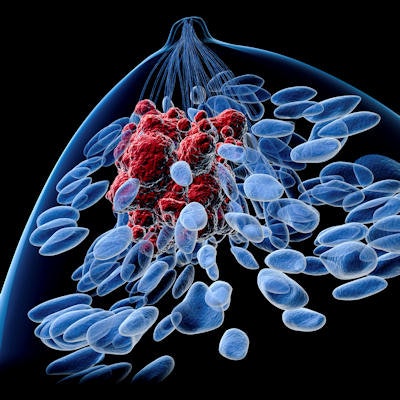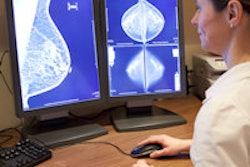
The shift from film-screen to digital mammography has improved cancer detection rates for diagnostic exams, but it has also increased the rate at which women are called back for biopsy, according to a study published online February 28 in Radiology.
The results are part of research that sought to update mammography performance benchmarks published by the Breast Cancer Surveillance Consortium (BCSC) in 2005 and to evaluate how diagnostic digital mammography is performing in the digital era, wrote a team led by Brian Sprague, PhD, from the University of Vermont Cancer Center. The study's findings are valuable in ascertaining how the move to digital is affecting breast imaging.
"In the hands of contemporary radiologists, this modern digital technology identifies more and more suspicious findings," he told AuntMinnie.com. "But the technology hasn't necessarily improved our ability to distinguish between benign and malignant lesions."
Benchmark update
 Brian Sprague, PhD, from the University of Vermont.
Brian Sprague, PhD, from the University of Vermont.The researchers used BCSC data to reassess the results from a study the consortium released in 2005 on the performance of diagnostic mammography -- as digital technology has essentially replaced film in breast imaging in the years since the report was published. The 2005 report was based on data from 1996 to 2001 (Radiology, February 28, 2017).
For the current study, the group looked at data from six BCSC registries from between 2007 and 2013, which included 418 radiologists and 92 facilities.
The cancer detection rate increased from 25.3 per 1,000 exams during the 1996-to-2001 time frame to 34.7 per 1,000 exams during the 2007-to-2013 period -- a change Sprague and colleagues attributed to improvements in mammography technology.
However, the study data also showed that the abnormal detection rate (the rate at which women are called back for biopsy) increased from 8% to 12.6%. In addition, the positive predictive value for biopsy (PPV2) dropped over the study time frame, from 31.5% to 27.5%, due to the biopsy callback rate increasing more than the cancer detection rate.
| Performance measures for diagnostic mammography | ||
| Performance measure | Film screen, 1996-2001 | Digital, 2007-2013 |
| Cancer detection rate per 1,000 | 25.3 | 34.7 |
| Abnormal interpretation rate (rate at which women are called back for biopsy) | 8% | 12.6% |
| PPV2 (positive predictive value of biopsy) | 31.5% | 27.5% |
| PPV3 (cancers per biopsies performed) | 39.5% | 30.4% |
Diagnostic digital mammography's false-positive rate for the 2007-to-2013 time frame was 4.8 per 1,000, its sensitivity was 87.8%, and its specificity was 90.5%, the authors wrote. Corresponding data from the 1996-to-2001 time frame for these measures were not available, Sprague told AuntMinnie.com.
As for radiologists' performance, the researchers found that 25% of radiologists had a cancer detection rate of less than 26.2 per 1,000, while the upper 25% of radiologists had a cancer detection rate of 44.7 per 1,000. The abnormal interpretation rate ranged from 5.9% to 18.2%.
Bang for the buck
The study findings may prove helpful to radiologists and imaging facilities in addressing the problem of high rates of benign biopsies, according to Sprague and colleagues.
"Individual radiologists and breast imaging facilities can use these results as benchmarks to assess how their diagnostic digital mammography performance compares to that from a national sample of women and radiologists," they concluded.
But in any case, there's no doubt that diagnostic digital mammography is a valuable tool for women who present with clinical signs of breast cancer, Sprague said.
"It's important to keep in mind that diagnostic mammography finds many more cancers than screening does -- 34 per 1,000 compared to screening mammography's five per 1,000," he said. "That's partly due to the population for which it's used, but still, it's a lot of bang for your buck."




















